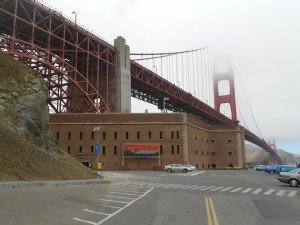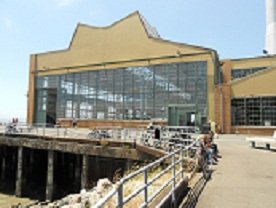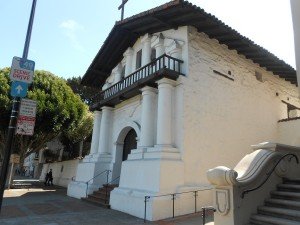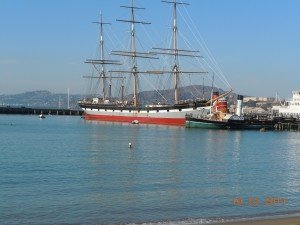Unique San Francisco Bay Area Attractions
Thank you for reading this post, don't forget to subscribe!
Fort Point
If you’re making a list of things to do in San Francisco California area you’ll make a good choice by adding a stop at Fort Point to your itinerary. Fort Point is one of the most unique historical sites the the United States. The Fort has been called “the pride of the Pacific,” “the Gibraltar of the West Coast,” and “one of the most perfect models of masonry in America.”
Where this fort is located could not be more unique. The site of Fort Point is directly under the south end of the Golden Gate Bridge and in the Golden Gate National Parks area. While visiting Fort Point just look up and you’ll see the bottom of the bridge’s south end. Probably one of the most unique views you’ll ever have.
To drive to Fort Point from the city or from points south, take Highway 101 north and exit right at the Golden Gate Bridge toll plaza before getting on bridge. Turn right at end of exit ramp and then left onto Lincoln Boulevard. Take the first left onto Long Avenue and follow onto Marine Drive. Fort Point is at its end.

Historic Richmond California Ford Plant
San Francisco things to do also include a visit to the old Ford Motor Company Richmond California plant. This is quite a significant historical venue. Richmond is located northeast and across the bay from San Francisco.
The area where the factory building still stands is at Point Richmond right on San Francisco Bay. This assembly plant, designed by Detroit architect Albert Kahn, produced some 49,000 jeeps and 91,000 additional military vehicles to aid America’s war effort during World War Two. The factory measured 500,000 square feet.
When the plant was built in 1930, the plan was to produce about 400 vehicles in an eight hour work shift. Total employment at the assembly plant was planned for 2,600. During the war years the plant’s activity was constant, twenty four hours a day and seven days a week. Since war time work shifts were scheduled one after the other the Ford plant and the Kaiser Shipyard meant that area roads had heavy traffic no matter what time of day.
When the war ended Richmond’s economy took a big hit. First the Kaiser Shipyard closed and then eventually the Ford Motor plant. Ford kept operating the Richmond facility after the war to help satisfy the pent up demand for civilian vehicles. Even so, the last Ford car built at this plant was in 1953 and the Ford plant closed for good in 1956. This of course was another hit to the Richmond economy.

When you visit the old Ford plant today you’ll see that it is located at the Rosie the Riveter WW II Home Front National Historical Park. see the exhibits at the old Ford plant and tour the museum located adjacent to the old Ford plant. The museum has an excellent presentation with numerous exhibits that show and explain how the war effort was handled on the home front by the people who built the vehicles and ships.
Directions to the Rosie the Riveter Visitor Education Center from the San Francisco or Oakland area is as follows. Take I-80 East, then take the I-580 West split after the Gilman St. off ramp. EXIT Harbour Way South, then turn Right onto Cutting Blvd, now make a right at the next stop light onto Harbour Way South and continue for 0.8 miles. Make a left into the gated parking lot passing the guard shack. Follow signs from there ending at Suite #3000. The entrance is on the south side of the building by the water.

Mission Dolores
The settling of California by the Spanish had everything to do with their mission system. From San Diego in the south to Sonoma in the north, the Spanish missions were essential in settling what was then called Alta California.
The building of Mission Dolores in San Francisco came shortly after the Juan Bautista de Anza Expedition of 1776 came to the Bay Area from Mexico with the direct intention of bringing settlers to the area.
De Anza’s expedition essentially first settled what is now the city of San Francisco. When de Anza arrived, his first two tasks were to find a suitable place for both a mission and for a presidio.
There are many interesting facts to know about Mission Dolores San Francisco. The site that de Anza had chosen for the mission was on the banks of a very small rivulet that he named Arroyo de los Dolores. This small stream emptied into a small lake.
Father Francisco Palou who was with the expedition held the first mass in a thatched hut. Later, Father Palou moved the mission to a better site a few blocks away to where it stands today.
The Dolores Mission, where it resides today, was formally dedicated in 1791 and hasn’t changed much since. The quadrangle of the mission was finally completed in 1798, twenty years after the missions founding. The small lake where the stream led was eventually covered up. Interestingly enough, the lake that was filled in and covered was eventually used for settlement with homes being built upon the land fill. This small section received considerable damage during the 1906 Earthquake.
See the Trips Into History articles on the links below…
Tour the WW II Submarine USS Pampanito
The Last Days of the California Stagecoach

San Francisco National Maritime Historical Park
Today, we’re fortunate to have a great place to visit at San Francisco’s Fishermans Wharf. It’s a place to see both steamboats and old sailing vessels from an earlier era.
The San Francisco National Maritime Historical Park is a very unique site and would be a good addition to your San Francisco vacation or weekend trip.
This maritime park is located in what is perhaps one of the most picturesque part of the United States. The park consists of a fleet of historic vessels, a visitor center, a very interesting maritime museum as well as a library/research facility. The park is located nearby where Hyde Street ends at Fishermans Wharf. The cable car and electric streetcars make it very convenient to get to.
One such early vessel permanently docked at the park is the sidewheeler “Eureka“. Like many old steamboats the Eureka has a rich history. The Eureka was built in Tiburon in Marin County in 1890. The vessel was first named the “Ukiah” to showcase the San Francisco and North Pacific Railway’s recent extension into the City of Ukiah on California’s north Pacific coast.
The first route for the Eureka was between San Francisco and Tiburon. An interesting construction fact regarding the Eureka was that it was built with a double-end design. This means that cars and people could embark or disembark from either end of the vessel.
Take a glance at the Eureka and you’ll notice that the front and back of the steamboat are identical. This includes pilot house. This new design may have been one of the most revolutionary of the time and certainly made the vessel more versatile.
This vessel which was then name the Ukiah carried troops and rail cars filled with munitions in aiding the World War One effort. Her war service however came with a big price. Transporting the extremely heavy rail cars stressed her hull and she had to be extensively repaired at government expense. During this era the Ukiah was the largest double ended designed vessel in the world. She could carry 2,300 passengers and about 120 cars.
Plenty of very unique and interesting things to do in the San Francisco Bay Area and we wanted to highlight a few of these in this article. We hope you enjoyed the article and had a chance to see the linked articles above which highlight even more good trip stops.
(Article and photos copyright 2014 Trips Into History)
